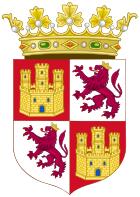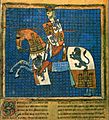Castilian House of Ivrea facts for kids
| Castilian House of Ivrea Casa de Ivrea |
|||
|---|---|---|---|
Quick facts for kids  Armorial of Castile and León |
|||
| Country: | Crown of Castile, Kingdom of Castile, Kingdom of León | ||
| Parent House: | House of Ivrea House of Jimenez (maternal) |
||
| Titles: | * King of Castile and Toledo | ||
| Founder: | Raymond of Burgundy | ||
| Final Ruler: | Peter of Castile | ||
| Founding Year: | 1126 | ||
| Dissolution: | 1369 | ||
| Cadet Branches: | *House of Trastámara | ||
The Castilian House of Ivrea was a royal family that ruled the Kingdom of Castile and Kingdom of León. This family started with Raymond of Burgundy. He married Urraca, who was the daughter of Alfonso VI of León and Castile.
Urraca became queen after her father died. Her son with Raymond, Alfonso VII, became king in 1126. The family ruled until 1369. Later, some of their relatives, the House of Trastámara, ruled Castile and Aragón until the 1500s.
Contents
History
How the Family Started
Raymond of Burgundy was a son of William I, Count of Burgundy. He came to Spain around 1086. He joined an army that was trying to capture the city of Tudela, Navarre.
In 1087, Raymond married Urraca, King Alfonso VI's daughter. They received the area of Galicia as a gift. Raymond died in 1107. The king's only son, Sancho, died the next year. This meant Urraca was next in line to be queen.
Urraca became queen in 1109. She had to fight against her husband and her own son to keep her crown. Her son, Alfonso VII, eventually became the first king from the Castilian House of Ivrea.
Kings of Castile and León
Alfonso VII decided to divide his kingdom between his sons. His son Sancho III received Castile and Toledo. His other son, Ferdinand II, received León and Galicia.
The kingdoms stayed separate for a while. Sancho III's son was Alfonso VIII of Castile. Ferdinand II's son was Alfonso IX of León. In 1197, Alfonso IX married Alfonso VIII's daughter. Later, her teenage brother died. This meant her son with Alfonso IX, Ferdinand III, inherited Castile.
Ferdinand III then reunited the kingdoms permanently when his father died. He passed them on to his son, Alfonso X.
Alfonso X had an older son named Ferdinand de la Cerda. Ferdinand died in 1275, leaving two sons. But Alfonso X's second son, Sancho, wanted to be the next king. The king preferred Ferdinand's sons, but the nobles supported Sancho. This led to a civil war. The family of Ferdinand's sons became known as the House of la Cerda.
Alfonso X died in 1284, and Sancho IV became king. Sancho IV's grandson was Alfonso XI. Alfonso XI had a legal son, Peter of Castile. He also had several sons born outside of marriage, like Henry and Fadrique.
In 1366, Henry attacked Peter. This started the Castilian Civil War. Peter was trapped in a fortress. During talks, Peter went into Henry's tent. Henry was hiding there and killed him. Peter had no legal sons. So, Henry became the new king, Henry II. He started a new royal family called the House of Trastámara. His brother Fadrique started the House of Enríquez family.
Family tree of Castilian House of Ivrea
Branches
- House of Ivrea, Kings of Castile († 1369)
- House of la Cerda, Pretenders to Castile († 1389)
- Second House of Lara, Lords of Lara († 1361)
- (illegitimate) House of Trastamara, Kings of Castile († 1504)
- Third house of Aragon, Kings of Aragon († 1516)
- (illegitimate) House of Aragona, Kings of Naples († 1550)
- Third house of Aragon, Kings of Aragon († 1516)
- House of la Cerda, Pretenders to Castile († 1389)
* (illegitimate) Aragona, Dukes of Bisceglie († 1512) * (illegitimate) Aragona, Dukes of Montalto († 1610) * (illegitimate) Aragona, Marquesses of Gerace († 1529)
-
-
-
- (illegitimate) Aragon, lords of Ballobar († 17th c.)
- (illegitimate) Aragon Gurrea, Dukes of Villahermosa († 1761)
- House of Aragon, Dukes of Segorbe († 1608)
- (illegitimate) Noroña, Counts of Gijon
- Second House of Meneses, Counts and Marquesses of Vila Real, Dukes of Caminha († 1668)
-
-
* Noronha, Counts of Linhares († 1647) * Castro, Counts of Monsanto and Marquesses of Cascais († 1745)
-
-
- (illegitimate) Henriques, lords of las Alcáçovas
- (illegitimate) House of Enríquez, Lords and Dukes of Medina de Rioseco († 1739)
- (illegitimate) Téllez de Castilla, Lords of Aguilar de Campoo († 1449)
- (illegitimate) Albuquerque, Counts of Albuquerque († 1445)
- Castilla, Lords of los Cameros († 1375)
- Castilla, Lords of Ledesma († 1312)
- Valencia, Lords of Valencia de Campos
- Second House of Haro, Lords of Biscay († 1348)
- House of Enríquez, lords of Puebla de los Infantes († late 14th c.)
- House of Manuel de Villena (†1935)
- Ponthieu, Counts of Aumale († 1302)
- Castilla, Lords of Marchena († 14th c.)
- Molina, Counts of Molina († 1321)
- (illegitimate) Fernandez, lords of Castroponce († 14th c.)
-
See also
 In Spanish: Casa de Borgoña (Castilla) para niños
In Spanish: Casa de Borgoña (Castilla) para niños
- Portuguese House of Burgundy
- House of Trastámara
Images for kids











